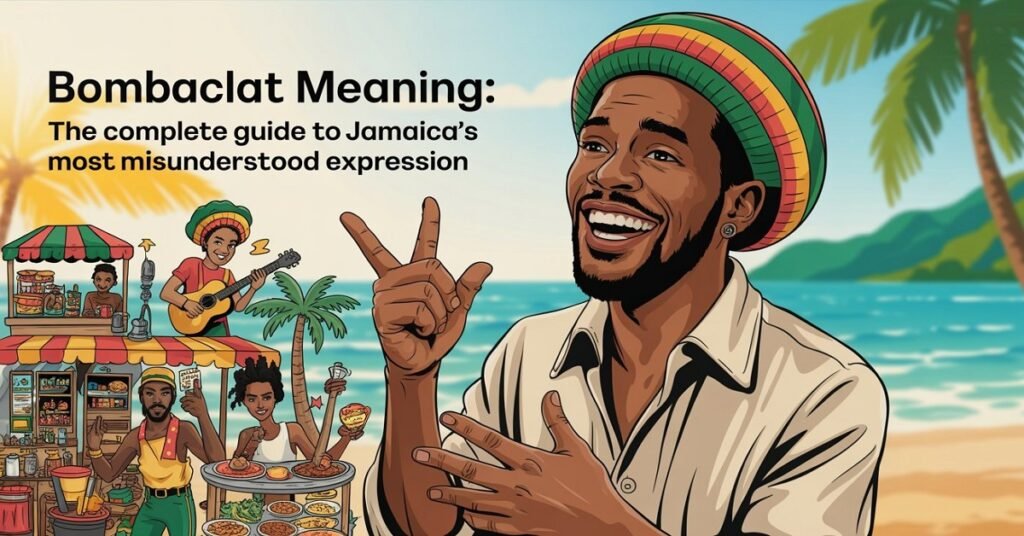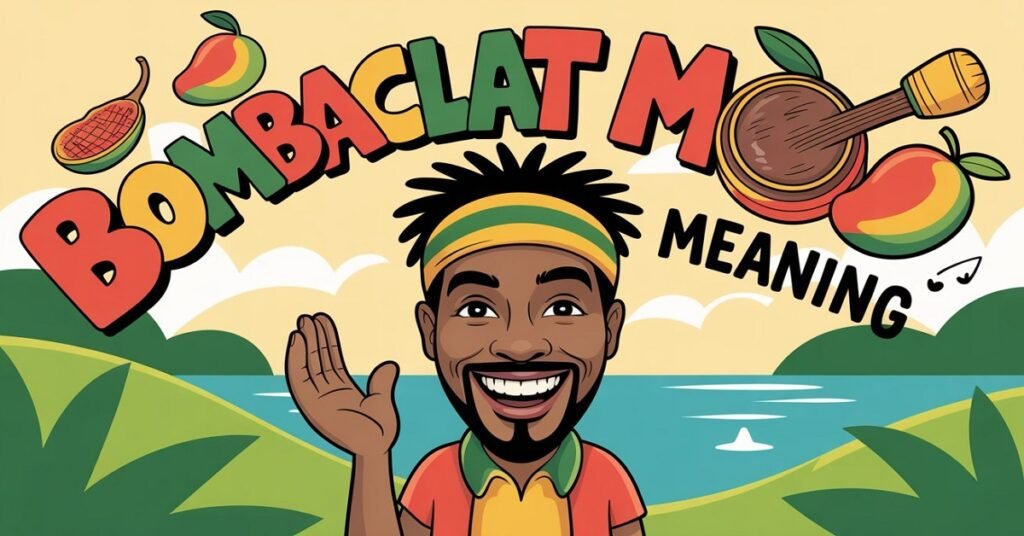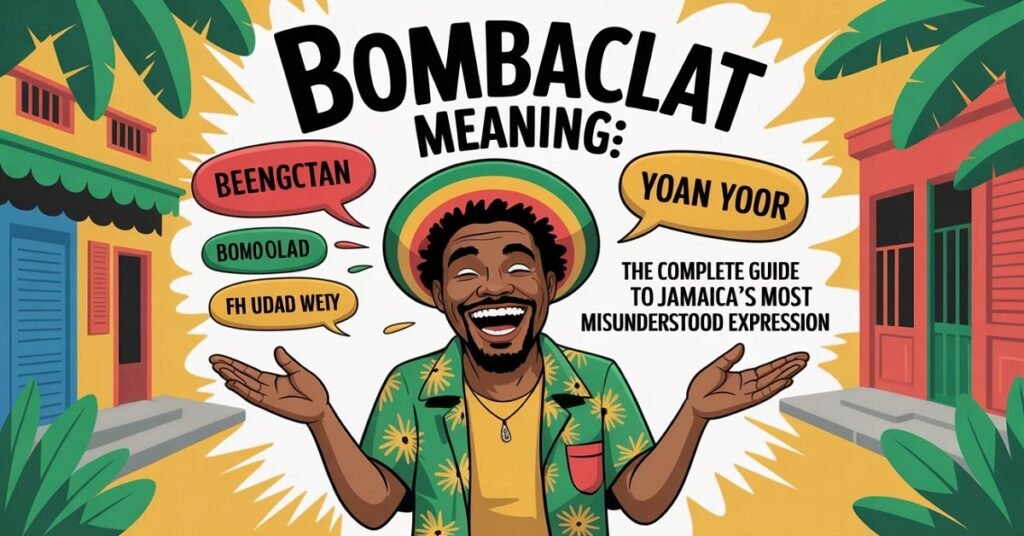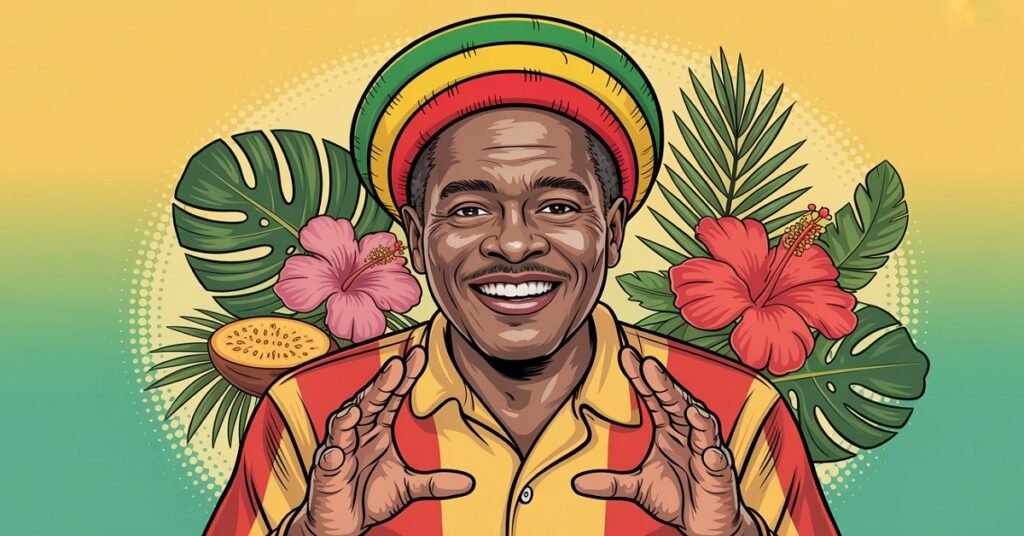Language evolves in fascinating ways, carrying cultural DNA across oceans and generations. Few words demonstrate this better than “bombaclat,” a Jamaican Patois expression that journeyed from Caribbean streets to global social media feeds. What started as a deeply rooted cultural term has become one of the internet’s most viral and misunderstood expressions.
This comprehensive guide explores the bombaclat meaning, tracing its historical origins, cultural significance, and modern evolution. Whether you encountered it through Twitter memes or dancehall music, understanding this word requires diving deep into Jamaican history, linguistics, and the delicate balance between cultural appreciation and appropriation.
By the end of this article, you’ll understand not just what bombaclat means, but why context matters in our interconnected world where words travel faster than ever before.

Understanding Bombaclat: Etymology and Literal Translation
Breaking Down the Compound
The bombaclat meaning becomes clearer when we examine its linguistic components. This compound word consists of two distinct elements that reflect Jamaica’s complex colonial history and African heritage.
“Bomba” or “bumba” refers to the buttocks or bottom, tracing its roots to West African languages that survived the Middle Passage. Enslaved Africans brought these linguistic elements to Jamaica, where they merged with colonial English to create what linguists now recognize as Jamaican Patois.
“Clat” or “claat” derives from the English word “cloth,” specifically referring to sanitary cloths or rags used for personal hygiene. In pre-modern Jamaica, before mass-produced sanitary products, these cloths served essential functions in daily life.
Combined, bombaclat literally translates to “butt cloth” or “sanitary cloth.” However, reducing this expression to its literal meaning misses the profound cultural and emotional weight it carries in Jamaican society.
Spelling Variations and Regional Differences
The bombaclat meaning remains consistent across different spellings, though variations reflect the oral tradition of Jamaican Patois. Common spellings include:
- Bombaclat
- Bumbaclot
- Bumbaclaat
- Bumboclaat
These variations emerged because Jamaican Patois developed primarily as a spoken language. Different parishes across Jamaica adopted slightly different pronunciations, leading to spelling inconsistencies when the term appeared in written form.
The “bomba” versus “bumba” distinction often relates to regional accents within Jamaica. Rural parishes might favor one pronunciation while urban areas prefer another, but the cultural impact remains identical.

The Historical Journey: From Plantation to Patois
Colonial Origins and Social Dynamics
Understanding the bombaclat meaning requires examining its emergence during Jamaica’s brutal colonial period. The term didn’t develop in isolation it arose from the intersection of African linguistic traditions, English colonial language, and the harsh realities of plantation life.
References to intimate bodily functions and sanitary cloths became expressions of defiance among enslaved populations. Using such terms served multiple purposes: they allowed coded communication that plantation owners couldn’t fully comprehend, and they provided emotional release in an oppressive system.
Dr. Hubert Devonish, a prominent Caribbean linguist, notes that many Jamaican expletives originated as forms of resistance. “These words carried power precisely because they referenced things colonial society deemed ‘improper’ or ‘uncivilized,'” he explains in his research on Caribbean creole languages.
Post-Independence Evolution
Jamaica’s independence in 1962 marked a turning point in how Jamaican Patois, including terms like bombaclat, gained cultural legitimacy. The bombaclat meaning expanded beyond its origins as the nation embraced its linguistic heritage.
During the 1960s and 70s cultural renaissance, influenced by Marcus Garvey’s teachings about Black pride and self-determination, Jamaican expressions gained new significance. What was once dismissed as “broken English” became recognized as a legitimate creole language with its own grammar, syntax, and cultural value.
This period saw bombaclat integrate more fully into mainstream Jamaican vernacular. The term appeared in early reggae lyrics, local theater productions, and everyday conversations across social classes.
Rastafarian Philosophy and Language Innovation
Rastafarian culture profoundly influenced the bombaclat meaning and usage patterns. Rastafarians developed sophisticated concepts around “clean” versus “unclean” elements, both physically and spiritually.
In Rastafarian philosophy, references to menstrual cloths or toilet rags as implied by bombaclat represent impurity. This spiritual dimension intensified the word’s offensive potential while simultaneously acknowledging its cultural authenticity.
The Rastafarian movement also emphasized “word sound power,” the belief that spoken words carry spiritual energy. This philosophy elevated bombaclat beyond mere profanity to a expression with genuine cultural and spiritual weight.

Modern Usage Patterns: From Streets to Screens
Emotional Spectrum and Contextual Applications
The bombaclat meaning encompasses a broad emotional spectrum, functioning as one of Jamaica’s most versatile expressions. Understanding its contextual applications reveals the sophistication of Jamaican Patois.
Expressing Anger or Frustration: When traffic gridlocks Kingston’s streets, a frustrated driver might exclaim, “Bombaclat! Traffic cyaan move!” The term provides emotional release while emphasizing the intensity of their frustration.
Conveying Surprise or Shock: Receiving unexpected news might prompt, “Bombaclat, you win di lottery!” Here, the word amplifies amazement while maintaining cultural authenticity.
Adding Emphasis or Intensification: Jamaicans often use bombaclat as an intensifying adjective: “That bombaclat car expensive!” This usage transforms the term from pure expletive to emphatic modifier.
Building Camaraderie: Among close friends, bombaclat can express casual exclamation without offensive intent. Context and relationship dynamics determine whether the usage strengthens or strains social bonds.
Generational Differences in Usage
The bombaclat meaning varies significantly across age groups within Jamaican society. Older generations, particularly those who lived through colonialism, often view the term with greater sensitivity.
Younger Jamaicans, especially those influenced by dancehall culture, use bombaclat more casually. This generational divide reflects broader changes in Jamaican society’s relationship with its linguistic heritage.
Professional settings require careful code-switching. Many Jamaicans seamlessly transition between Patois expressions like bombaclat in casual settings and standard English in formal environments.
The Digital Revolution: Bombaclat Goes Global
The 2019 Twitter Meme Explosion
The bombaclat meaning gained international recognition through a viral Twitter trend that began in September 2019. Users posted images—often random or humorous photos—with the single word “bombaclat” as the caption, prompting others to provide descriptions or reactions.
This meme format exploded across Twitter, generating millions of interactions within weeks. The trend demonstrated social media’s power to spread cultural expressions far beyond their origins, though often without proper context.
What made this particular meme successful was its simplicity and mystery. Users who didn’t understand the bombaclat meaning still participated, creating an inadvertent cultural exchange that introduced Jamaican Patois to global audiences.
Instagram and TikTok Adaptations
Following Twitter’s success, the bombaclat meme migrated to Instagram and TikTok, evolving from static images to dynamic video content. Influencers and content creators adapted the format, often incorporating dancehall music or Jamaican cultural elements.
However, this evolution raised concerns within the Jamaican community about cultural appropriation and commercialization. Some creators used bombaclat without understanding its cultural significance, reducing a meaningful expression to trendy content.
Music Industry Impact
The global recognition of bombaclat meaning through social media created new opportunities for Jamaican artists. Dancehall and reggae musicians found international audiences more receptive to authentic Patois lyrics.
Artists like Vybz Kartel, Popcaan, and Spice gained broader recognition partly because global audiences became more familiar with Jamaican expressions through viral memes. This cultural bridge building, while sometimes problematic, opened doors for authentic Caribbean voices.
Cultural Sensitivity and Respectful Usage
The Jamaican Community’s Perspective
The global spread of bombaclat created complex reactions within Jamaican communities worldwide. Some welcomed the international recognition of their linguistic heritage, while others expressed concern about misuse and trivialization.
Professor Carolyn Cooper, a leading expert on Jamaican popular culture at the University of the West Indies, observes: “When our expressions go viral, we face a double-edged sword. Global recognition validates our culture, but context often gets lost in translation.”
Many Jamaicans appreciate when foreigners show genuine interest in understanding the bombaclat meaning and cultural context. However, casual usage without cultural awareness can feel exploitative, particularly given Jamaica’s history of cultural extraction.
Guidelines for Respectful Cross-Cultural Communication
Understanding bombaclat meaning responsibly requires following certain principles:
Learn the Historical Context: Recognize the term’s origins in colonial resistance and cultural survival. This background knowledge demonstrates respect for Jamaican heritage.
Understand Social Dynamics: Bombaclat remains a strong expletive in Jamaican culture. Using it casually in inappropriate settings can cause offense or misunderstanding.
Support Authentic Voices: When engaging with Jamaican culture, prioritize supporting actual Jamaican creators, artists, and businesses rather than simply adopting surface-level expressions.
Practice Cultural Humility: Acknowledge that understanding bombaclat meaning fully requires immersion in Jamaican culture that extends beyond social media exposure.
Linguistic Analysis: Academic Perspectives on Bombaclat
Sociolinguistic Significance
From an academic standpoint, the bombaclat meaning represents fascinating case studies in creole language development, cultural resistance, and digital age linguistics.
Caribbean linguists recognize bombaclat as part of a broader pattern where intimate or taboo references become powerful expletives. Similar patterns exist in cultures worldwide, but Jamaica’s colonial history adds unique dimensions to these linguistic developments.
The term’s structure—combining African-rooted “bomba” with English-derived “clat”—exemplifies how creole languages preserve multiple cultural traditions while creating something entirely new.
Digital Age Evolution
Social media’s impact on bombaclat meaning demonstrates how digital platforms accelerate linguistic change. What once required generations to spread across cultures now happens in weeks through viral content.
This acceleration creates new challenges for cultural preservation and authentic representation. While global recognition can validate marginalized languages, rapid spread often strips away crucial context and meaning.
Practical Alternatives for Respectful Expression
Understanding bombaclat meaning includes knowing when alternative expressions might be more appropriate. Here are culturally neutral options organized by emotional context:
For Expressing Surprise:
- “Unbelievable!”
- “No way!”
- “Are you serious?”
- “That’s incredible!”
For Showing Frustration:
- “This is ridiculous!”
- “I can’t believe this!”
- “What a mess!”
- “This is driving me crazy!”
For Emphasizing Points:
- “Absolutely incredible”
- “Completely amazing”
- “Totally unacceptable”
- “Extremely important”
For Casual Exclamations:
- “Oh my goodness!”
- “Holy cow!”
- “Good grief!”
- “For crying out loud!”
These alternatives allow expressive communication without potentially appropriating or misusing culturally specific terms like bombaclat.
The Broader Context: Jamaica’s Linguistic Heritage
Related Expressions and Cultural Patterns
The bombaclat meaning exists within a family of similar Jamaican expressions, each carrying distinct cultural weight and usage patterns.
“Raasclat” and “bloodclat” follow similar compound structures, combining different elements with “clat” to create expressions of varying intensity. Understanding these relationships provides deeper insight into Jamaican linguistic creativity and cultural expression.
These terms function within sophisticated grammatical structures that linguists increasingly recognize as legitimate language systems rather than corrupted English.
Supporting Cultural Preservation
True appreciation of bombaclat meaning involves supporting broader efforts to preserve and celebrate Jamaican linguistic heritage. This includes:
Educational Initiatives: Supporting programs that teach Caribbean creole languages in academic settings.
Cultural Documentation: Contributing to projects that record and preserve authentic Jamaican expressions and their contexts.
Economic Support: Choosing to support Jamaican creators, artists, and businesses that authentically represent their culture.
Respectful Engagement: Approaching Jamaican culture with genuine curiosity and respect rather than superficial adoption of trendy expressions.
Conclusion: Language as Cultural Bridge
The journey of bombaclat from Jamaican streets to global social media illustrates both the power and responsibility that comes with cultural exchange in our digital age. Understanding its meaning requires more than memorizing definitions—it demands appreciation for the complex history, cultural resistance, and linguistic creativity that shaped this remarkable expression.
As language continues evolving in our interconnected world, the bombaclat phenomenon offers valuable lessons about cultural sensitivity, authentic representation, and the difference between appreciation and appropriation.
For those encountering bombaclat through memes or music, take time to understand its deeper significance. For Jamaicans sharing their linguistic heritage globally, consider how to maintain authenticity while building cultural bridges.
Ultimately, bombaclat meaning transcends its literal translation to represent the resilience, creativity, and cultural richness of Jamaican people. By approaching it with respect and understanding, we honor not just a word, but the entire community that created and preserved it across centuries of challenge and change.
Language serves as one of humanity’s most powerful tools for connection and understanding. When we take time to truly comprehend expressions like bombaclat their origins, meanings, and cultural significance we build bridges of authentic appreciation that benefit everyone involved.
For more visit: https://prayersland.com/

Noah James is the author behind PrayersLand, a blog dedicated to inspiring faith, hope, and spiritual growth. With a deep passion for prayer and devotion, he shares heartfelt reflections, powerful prayers, and uplifting insights to strengthen believers on their spiritual journey. His writings aim to bring comfort, wisdom, and divine connection.

